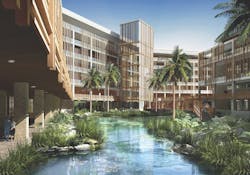GBBN designers take on wellness research
The term wellness has been kicked around a lot in healthcare design circles lately. But what precisely do we mean by wellness? And, assuming wellness is a good thing, how can designers create healthcare facilities that enhance wellness?
Responses to those questions are embedded in a rigorous case study on “salutogenesis”—“the origin of health,” a term developed by Israeli American medical sociologist Aaron Antonovsky in his 1979 book, Health, Stress and Coping.
Three healthcare designers at GBBN Architects, Cincinnati—Angela Mazzi, AIA, ACHA, EDAC; Marcene Kinney, AIA, LEED AP; and Jon Hofmann, AIA, LEED AP—wondered why healthcare environments are seen as places where the experience of treatment is worse than the disease. Instead of being a place of dread, they wanted to know: Could a hospital provide a therapeutic environment that is “truly immersive, encouraging a patient to feel at ease and be engaged?” If so, would that promote wellness?
To test this hypothesis, the team studied one of GBBN’s own projects, The Sanya Fuwai Center. Situated on 15 acres in the mountains of the tropical island of Hainan, in China, it is more like a resort than a hospital. It provides complete inpatient and outpatient care, along with complementary therapies in a spa and hotel to allow for “relaxing, resetting, and recharging.”
Their report, “A Healthy State of Mind: Psychosocial Triggers to Wellness,” explores “psychosocial behavior cues” that provide an antidote to the anxiety and isolation that patients experience in most healthcare settings. They discuss four “salutogenic design drivers”—prospect and refuge, sense of coherence, relaxation response, and the science of happiness (who knew?)—and discuss their impact on five types of spaces: quiet, communal, casual, interactive, and season.
The GBBN researchers found several factors contribute to a psychological state that is receptive to healing:
• Incorporating elements that visually reference familiar positive environments, such as retail, residential, and recreational spaces. Provision should be made for walking paths, work areas, areas of contemplation, and destination points.
• Allowing choice and control in how the environment can be used and manipulated, through the provision of movable furniture, “personalization areas,” and variety in the types of spaces.
• Reinforcing the level of socialization appropriate to the activity within the environment through the use of proxemics—how much space people feel it necessary to set between themselves and others.
• Connection to nature for wayfinding and as a focal point within a space. Access to natural light is another key dimension of nature.
Download the 28-page paper at http://bit.ly/29SNsqA.

